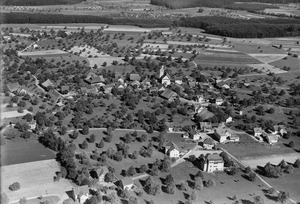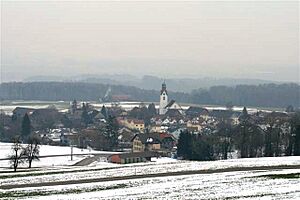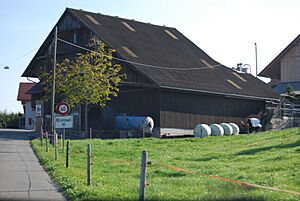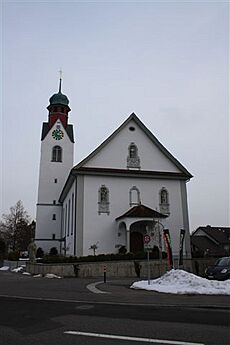Beinwil (Freiamt) facts for kids
Quick facts for kids
Beinwil (Freiamt)
|
||
|---|---|---|
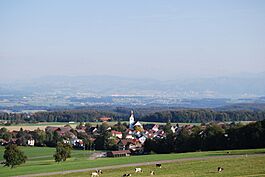 |
||
|
||
| Country | Switzerland | |
| Canton | Aargau | |
| District | Muri | |
| Area | ||
| • Total | 11.31 km2 (4.37 sq mi) | |
| Elevation | 580 m (1,900 ft) | |
| Population
(Dec 2020 )
|
||
| • Total | 1,183 | |
| • Density | 104.60/km2 (270.91/sq mi) | |
| Postal code |
5637
|
|
| Surrounded by | Auw, Benzenschwil, Geltwil, Hohenrain (LU), Lieli (LU), Mühlau, Müswangen (LU), Sulz (LU) | |
Beinwil (Freiamt) is a small town, also called a municipality, in Switzerland. It is located in the Muri district within the canton of Aargau.
Contents
History of Beinwil (Freiamt)
People have lived in the area around Beinwil for a very long time. We know this because some items from the Roman era have been found here. The town of Beinwil was first written about in the year 1153. Back then, it was called Beinwilare. Until 1950, it was known as Beinwil bei Muri.
A long time ago, much of the land in Beinwil belonged to a place called Muri Abbey. This was a very old monastery. In 1239, a person named Hartmann Visilere gave all his land and rights in Beinwil to another monastery, the Cistercian Kappel Abbey.
Later, in 1415, the city of Zurich took over this property. Zurich also gained control over the local courts in 1527. These rights were then sold to a family from Lucerne in 1586. Finally, in 1614, Muri Abbey bought them back.
The Story of St. Burkard
The history of Beinwil is also connected to a special religious journey, called a pilgrimage. This pilgrimage was to the grave of St. Burkard of Beinwil. He was the first pastor, or priest, in Beinwil and died around 1192. People started to honor him in the 1200s, and he was officially recognized as a saint in 1817.
The main church in Beinwil, called the Church of Saint Peter and Paul, was first mentioned in 1239. It was completely rebuilt between 1619 and 1621. Since 1808, it has also been known as the Church of St. Burkhard.
Farming in Beinwil
For a long time, farming has been the most important way people make a living in Beinwil. In 1990, almost half of all workers in the town (46%) were involved in agriculture.
Geography of Beinwil (Freiamt)
Beinwil (Freiamt) covers an area of about 11.28 square kilometers (4.36 square miles). A large part of this land, about 75.6%, is used for farming. Forests cover about 17.9% of the area. The remaining land, about 6.6%, is where buildings and roads are located.
Most of the forested land is covered with thick trees. A small part has orchards or small groups of trees. For farming, about 40.4% of the land is used for growing crops. Another 32.9% is used for pastures where animals graze.
The town is located on the eastern side of a hill called the Lindenberg. Beinwil (Freiamt) includes the main village of Beinwil. It also has smaller villages, known as hamlets, like Wiggwil, Brunnwil, Winterschwil, and Wallenschwil. You can also find Schloss Horben, a castle, and a small chapel in Horben.
Beinwil's Coat of Arms
The blazon (official description) of Beinwil's coat of arms is "Or a Linden-tree eradicated Vert." This means it shows a green linden tree with its roots showing, on a gold background.
People of Beinwil (Freiamt)
Beinwil (Freiamt) has a population of about 1,030 people. As of June 2009, about 8.8% of the people living here were from other countries. Over ten years, from 1997 to 2007, the population grew by about 3.5%.
Most people in Beinwil (Freiamt) speak German (98.4%). A smaller number of people speak Albanian (0.5%) or Italian (0.2%).
Age Groups
In 2008, the population was divided into different age groups:
- Children aged 0-9: 12.8%
- Teenagers aged 10-19: 14.0%
- Young adults aged 20-29: 14.8%
- Adults aged 30-39: 13.0%
- Adults aged 40-49: 15.7%
- Adults aged 50-59: 13.4%
- Seniors aged 60-69: 8.8%
- Seniors aged 70-79: 4.1%
- Seniors aged 80-89: 2.8%
- Seniors aged 90 and older: 0.5%
Homes and Housing
In 2000, there were 324 private homes and apartments in Beinwil (Freiamt). On average, there were 2.9 people living in each home. About 55.8% of the homes were owned by the people living in them.
In 2008, 140 of the homes (about 34.3%) were single-family houses. There was only 1 empty apartment, which means almost all homes were occupied.
Politics
In the 2007 national election, the most popular political party was the SVP, which received 41.7% of the votes. Other popular parties were the CVP (31%), the FDP (10.1%), and the SP (6.3%).
The number of people living in Beinwil (Freiamt) has changed over time:
| Historical population | ||
|---|---|---|
| Year | Pop. | ±% |
| 1850 | 871 | — |
| 1900 | 701 | −19.5% |
| 1950 | 759 | +8.3% |
| 2000 | 942 | +24.1% |
Important Heritage Sites
Some buildings and areas in Beinwil (Freiamt) are considered very important historical sites in Switzerland. These include the farm house at Winterschwil 8, the Catholic church of St. Burkard, and Horban Castle. The entire hamlets of Wiggwil and Winterschwil are also recognized as important heritage sites.
Economy of Beinwil (Freiamt)
In 2007, the unemployment rate in Beinwil (Freiamt) was very low, at 1.29%. This means most people who wanted to work had jobs.
In 2005, many people worked in different parts of the economy:
- Primary sector: 141 people worked in farming and related jobs. There were 47 businesses in this area.
- Secondary sector: 103 people worked in manufacturing and industry. There were 17 businesses in this area.
- Tertiary sector: 82 people worked in services, like shops or offices. There were 24 businesses in this area.
Many people who live in Beinwil (Freiamt) travel to other towns for work. In 2000, about 69.3% of the residents worked outside the municipality. About 53.4% of workers used a private car to get to work, while 6% used public transportation.
Religion in Beinwil (Freiamt)
According to the 2000 census, most people in Beinwil (Freiamt) are Roman Catholic (82.2%). About 10.0% belong to the Swiss Reformed Church.
Education in Beinwil (Freiamt)
Switzerland generally has a very well-educated population. In Beinwil (Freiamt), about 80% of adults (aged 25-64) have completed either high school or a higher level of education, like university.
In the 2008/2009 school year, there were 107 students attending primary school in the municipality.
See also
 In Spanish: Beinwil (Freiamt) para niños
In Spanish: Beinwil (Freiamt) para niños





